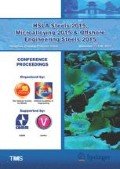Abstract
X90 pipeline steel requires ultra low for sulfur content and gas content in the smelting process. The secondary refining process is very important for X90 pipeline in smelting process and the control of cleanliness is the key for the secondary refining process in the steelmaking process for Pretreatment of hot metal → LD → LF refining → RH refining → Calcium treatment → CC. In the current paper, the cleanliness control method of secondary refining was analyzed for the evolution of non-metallic inclusions in the secondary refining prcess and related changes for composition in steel. The size, composition and the type of the non-metallic inclusions were analyzed by aspex explorer automated scanning electron microscope in X90 pipeline samples for 20mm * 25mm * 25mm by the line cutting. The results show that the number of non-metallic inclusions in steel decrease from the beginning of the LF refining to the RH refining. In the composition of the Non-metallic inclusions, the initial non-metallic inclusions of alumina is converted to two comple-type non-metallic inclusions. Most of them, the non-metallic inclusions were composed by the calcium aluminate and CaS. The others are that the spinel is the core, peripheral parcels calcium aluminate nonmetallic inclusions for complex-type non-metallic inclusions. For the size of the non-metallic inclusions, the non-metallic inclusions for size larger than 100µm is converted to 5 ~ 20µm based small size non-metallic inclusions. While the S content of the steel decreased from 0.012% to 0.0012% or less, Al content is kept at between 0.025% to 0.035% and the quality for the casting slab satisfies the requirement of the steel. The ratings for various types of the non-metallic inclusions are 1.5 or less. The control strategy for the inclusions in 90 pipeline is small size, diffuse distribution and little amount of the deformation after rolling. On the contrary, the specific chemical composition of the inclusions is not important, single component in the inclusions is better.
Access this chapter
Tax calculation will be finalised at checkout
Purchases are for personal use only
Preview
Unable to display preview. Download preview PDF.
References
H. R. Gaye. The Making, Shaping and Treating of Steel. 11th Ed. Pittsburgh: The AISE Steel Foundation, 2003.
Y. Ito. Kinetics of shape control of alumina inclusions with calcium treatment in line pipe steel for sour service[J]. ISIJ International, 1996, 36(s): 148.
Y. Ito, N. Seikoh, K. Yoshiei. Shape control of alumina inclusions by double calcium addition treatment[J]. Tetsu-to-Hagane, 2007, 93(5): 355.
D.C. Gatellier. Experimental determination of CaO and CaS solubilities in liquid steel consequences for inclusions shape control by calcium[J]. TetsutoHagane, 1984, (6): 872.
Y Wang, M. Valdez, S. Sridhar. Formation of CaS on Al2O3-CaO inclusions during solidification of steels[J]. Metallurgical and Materials Transactions B, 2002, (33B): 625.
Author information
Authors and Affiliations
Rights and permissions
Copyright information
© 2016 TMS
About this paper
Cite this paper
Chu, R.S., Liu, J.G., Li, Z.J. (2016). Study on the Control of Cleanliness for X90 Pipeline in the Secondary Refining Process. In: HSLA Steels 2015, Microalloying 2015 & Offshore Engineering Steels 2015. Springer, Cham. https://doi.org/10.1007/978-3-319-48767-0_34
Download citation
DOI: https://doi.org/10.1007/978-3-319-48767-0_34
Publisher Name: Springer, Cham
Print ISBN: 978-3-319-48614-7
Online ISBN: 978-3-319-48767-0
eBook Packages: Chemistry and Materials ScienceChemistry and Material Science (R0)

